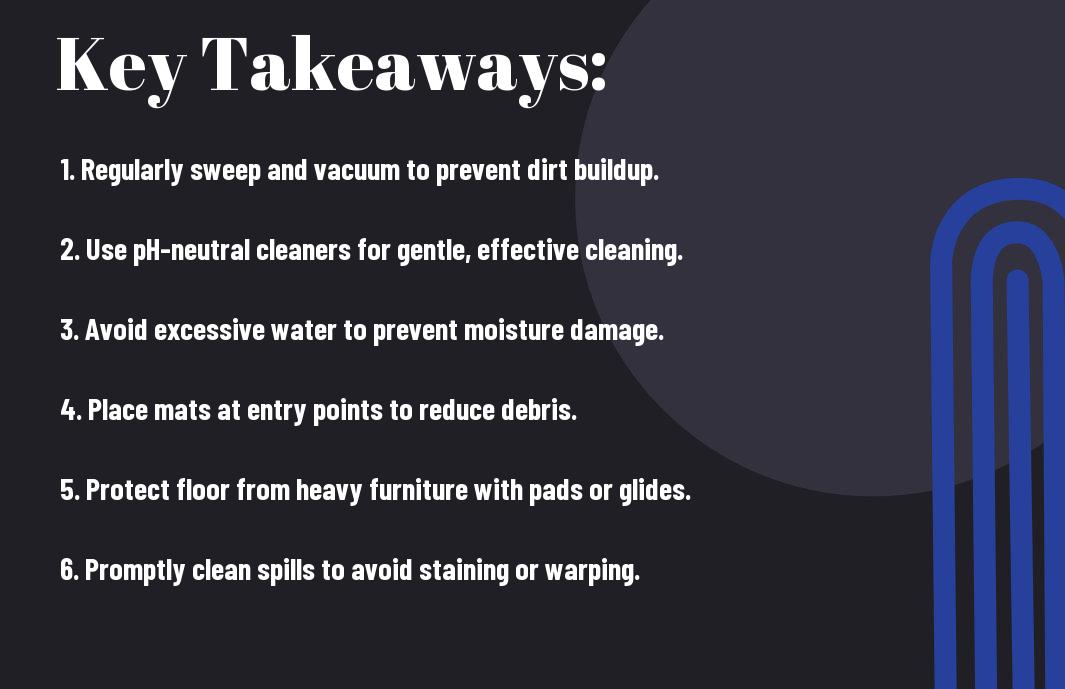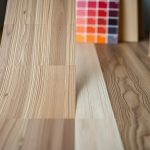With the right care and attention, your dry back vinyl flooring can remain beautiful and functional for years to come. Understanding best practices for maintenance is vital to ensure that your flooring withstands daily wear and tear while retaining its appearance. In this blog post, you will learn valuable tips and techniques to keep your vinyl flooring in excellent condition, enhancing its durability and aesthetic appeal.
Protecting Your Investment: Preemptive Measures
Taking proactive steps to protect your dry back vinyl flooring can significantly extend its lifespan and maintain its appearance. Simple actions like selecting appropriate furniture and strategically using mats can safeguard against wear and tear. Invest time and resources in these precautions to preserve your flooring’s beauty and utility for years to come.
Choosing the Right Furniture and Accessories
Select furniture with soft, rounded edges and use felt pads underneath heavy items to reduce the risk of scratches and indentations on your flooring. Heavy furniture can leave permanent marks, while errant chair legs may scrape the surface. Opting for lightweight furniture that is easy to move can also prevent damage when rearranging your space.
Utilizing Mats and Rugs to Guard Against Scratches
Mats and rugs serve as necessary barriers against dirt and debris that can scratch your dry back vinyl flooring. Place them at entryways to trap mud and stones that would otherwise be tracked inside. This additional layer of protection not only helps maintain your floor’s finish but also makes cleaning easier and more efficient in the long run.
Integrating mats in high-traffic areas and under kitchen tables can significantly reduce wear. Choose mats with a rubber backing to ensure they stay in place and avoid sliding. Additionally, selecting washable rugs can simplify upkeep, allowing you to maintain a clean and safe environment. Regular rotation and cleaning of these mats further enhance floor protection, keeping your investment looking pristine while minimizing maintenance efforts.

The Power of Regular Maintenance: Cleaning Protocols
Regular maintenance is the linchpin to keeping your dry back vinyl flooring looking pristine and ensuring it lasts for years. Establishing a consistent cleaning protocol not only preserves its surface but also prevents dirt and grime build-up that can degrade quality over time. Incorporate both daily and deep cleaning strategies into your routine to experience the full benefits of your flooring investment.
Daily Cleaning Routines: Sweep, Mop, Shine
Adopting a daily cleaning routine is crucial in keeping your vinyl flooring vibrant. Begin by sweeping or vacuuming to remove loose dirt and debris, followed by a damp mopping with a gentle cleaner specifically designed for vinyl surfaces. This simple ritual prevents scratches and maintains the shine, ensuring your floors remain welcoming and attractive.
Deep Cleaning Strategies: The Refresh Every Few Months
Every few months, investigate a more thorough cleaning process to rejuvenate your flooring. This involves using a deeper cleaning solution designed for vinyl and a scrub brush to remove tough stains or embedded dirt. Following up with a rinse using a microfiber mop will clear any residual cleaning product, leaving your floors looking brand new.
During the deep cleaning process, consider implementing a scrub-and-rinse strategy. Start by applying a specialized vinyl cleaner to high-traffic areas and allowing it to penetrate for a few minutes. Then, using a soft-bristle brush, gently scrub the surface to lift away grime. Finish by rinsing with clean water to prevent sticky residue from forming. This concentrated approach will not only refresh your flooring’s appearance but also contribute to a longer lifespan by keeping the material free from buildups that can cause premature wear. Regular deep cleaning boosts your vinyl flooring’s resilience, ensuring it holds up against daily wear and tear.
The Dangers of Neglect: Identifying and Addressing Damage
Failing to maintain your dry back vinyl flooring can lead to serious issues that compromise its appearance and function. Damage caused by water exposure, heavy furniture, or even simple wear and tear can escalate if not addressed promptly. Identifying early signs—such as warping, lifting edges, or discolored areas—allows you to tackle these problems head-on, preventing the necessity for a complete replacement and extending the life of your flooring.
Common Issues: Scratches, Scuffs, and Fading
Over time, scratches and scuffs can accumulate on your dry back vinyl flooring, making it appear worn. While minor surface abrasions might seem insignificant, they can become more pronounced if left untreated. Fading due to UV exposure or neglect can also detract from your flooring’s overall aesthetic appeal, diminishing the vibrancy of colors. Regular inspection can help you catch these issues early and keep your floors looking fresh.
Repair Methods: Quick Fixes vs. Professional Help
When damage does occur, you have options for repairs. Quick fixes may include using a vinyl floor repair kit for minor scratches or applying a floor polish to restore shine. For deeper cuts or extensive fading, seeking the assistance of a professional might be necessary to ensure a seamless repair. Knowing which method to use can save you time and money in the long run.
Quick fixes are often accessible and can remedy minor imperfections swiftly, such as using a vinyl-specific patching compound or adhesive film to cover small scratches. On the other hand, professionals bring valuable expertise to the table, particularly for larger areas needing repair. They can assess the damage comprehensively and often use specialized tools and techniques to achieve results that might be hard to replicate on your own. Weighing the severity of the damage along with your DIY comfort level can guide you toward the best solution.
Seasonal Considerations: Adapting Care Techniques
Adapting your maintenance techniques to fit the seasons can greatly enhance the longevity of your dry back vinyl flooring. Each season brings unique challenges and opportunities that, when addressed properly, keep your floors in top condition. From managing moisture levels in winter to combating summer heat, tailoring your approach according to the weather can ensure your flooring remains resilient year-round.
Climate Impact: Humidity and Temperature Effects
Changes in humidity and temperature can significantly influence the performance of dry back vinyl flooring. High humidity can lead to mold growth, while extreme cold might cause cracking. In response to your local climate, monitor indoor humidity levels—ideally between 30-50%—and adjust your ventilation and heating practices accordingly.
| Climate Condition | Recommended Action |
|---|---|
| High Humidity | Use dehumidifiers to minimize moisture. |
| Low Humidity | Consider humidifiers to maintain moisture levels. |
| Extreme Cold | Avoid letting temperatures drop below 60°F. |
| High Heat | Shield floors from direct sunlight with curtains. |
Seasonal Maintenance Schedule: A Year-Round Guide
A seasonal maintenance schedule tailored for your dry back vinyl flooring keeps cares consistent and comprehensive. Regular activities include thorough cleaning, checking for signs of wear, and making necessary adjustments to cleaning agents based on changing humidity and temperature. By honing in on a set timeframe—for example, deep cleaning in spring and fall—you ensure your flooring remains in excellent condition through all seasons.
Incorporate a structured routine into your calendar to enhance the upkeep of your flooring. For instance, during spring and fall, implement deeper cleaning sessions to tackle accumulated dirt and debris. Summer can be great for routine inspections—watch for sun damage or signs of heat wear—and winter is ideal for moisture control measures to prevent mold. By segmenting your tasks throughout the year, you foster a proactive maintenance strategy that aligns effectively with each season’s unique demands.
Longevity Through Awareness: Educating Your Household
Your vinyl flooring’s lifespan greatly depends on the collective effort of everyone in your home. When each family member understands the importance of maintaining the flooring, it leads to fewer scratches, scuffs, and overall neglect. Sharing tips about proper cleaning methods, furniture placement, and potential hazards can significantly reduce damage. Make it a family mission to treat your flooring with care, ensuring lasting beauty and functionality.
Sharing Best Practices with Family and Friends
Establishing Rules for Foot Traffic and Shoes
Setting rules for foot traffic and shoe usage helps protect your vinyl flooring from unnecessary wear. Limiting high-heel shoes, cleats, or abrasive footwear indoors can prevent scratches and dents. Designate shoe-free zones, particularly in areas that experience heavy foot traffic, like hallways and living rooms. Consider placing doormats at entrances to trap dirt and debris before they reach your flooring, which will extend its lifespan significantly.
This can be particularly effective when communicated to both family members and visitors alike. When establishing a shoe policy, take the time to explain the rationale behind it—emphasizing the investment you’ve made in your flooring. A simple sign at the entrance can remind guests to remove their shoes, and having a designated area for shoe storage helps keep your home organized and protects the flooring. Promoting this understanding not only conserves your flooring’s integrity but also cultivates a more respectful atmosphere towards shared living spaces.
To wrap up
Summing up, maintaining your dry back vinyl flooring is important for ensuring its longevity and performance. By regularly cleaning with appropriate methods, avoiding harsh chemicals, and protecting it from heavy impacts and excessive moisture, you can keep your floors looking great for years. Additionally, consider using area rugs in high-traffic zones and periodically inspecting for damage to address issues early. By incorporating these practices, you will enhance the durability and aesthetic appeal of your vinyl flooring, making it a worthwhile investment for your home.


